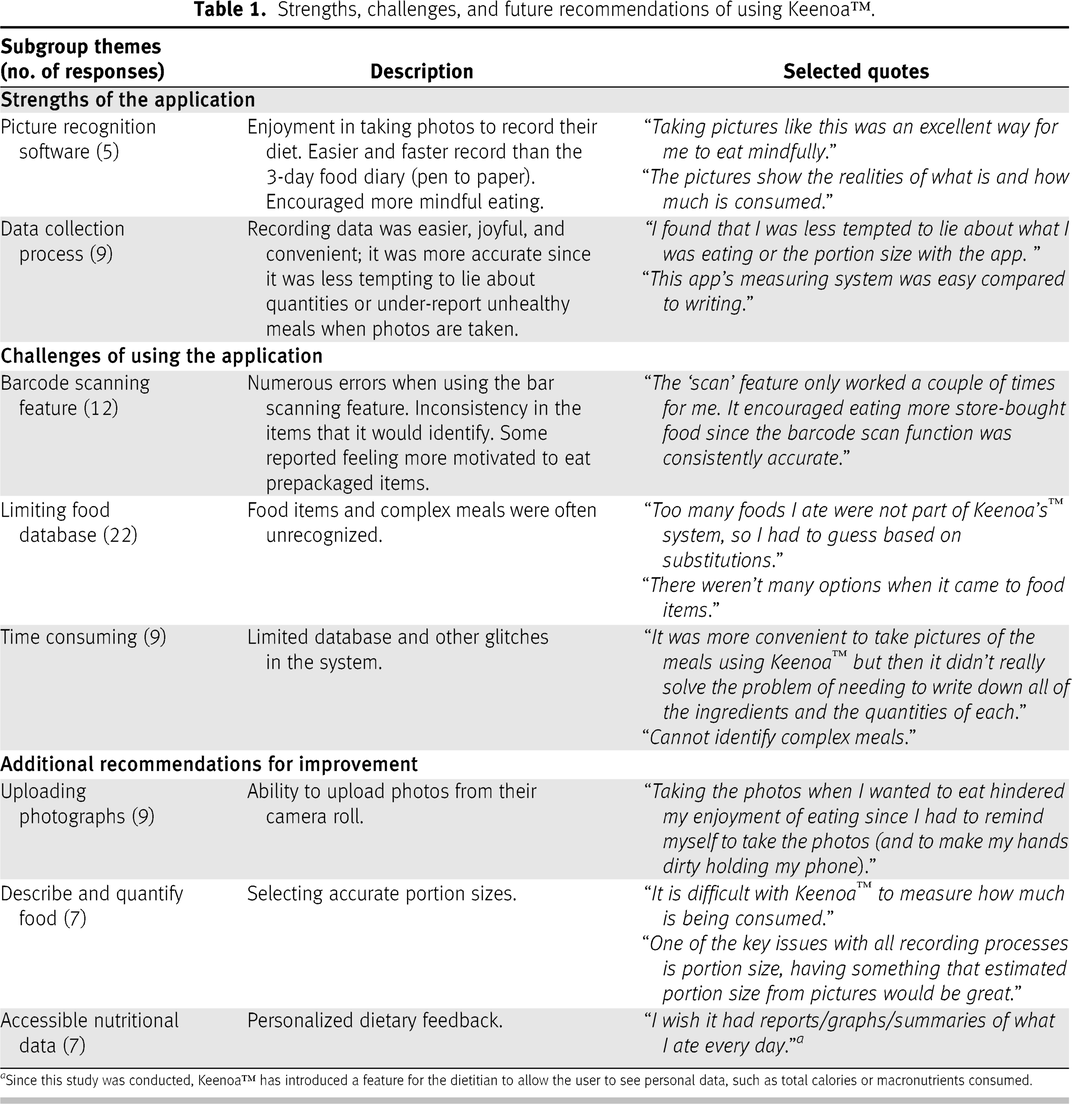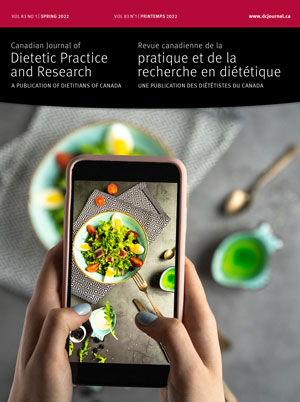INTRODUCTION
Registered dietitians (RD) rely on different methods of dietary assessment to evaluate food intake and obtain information on nutrients consumed [
1]. These include pen and paper methods such as 24-hour recalls, 3-day food diaries (3DFD), and food frequency questionnaires [
2]. While each of these methods have their strengths, all have limitations that speak to participant burden, inability to recall details of meals, and the lack of literacy and motivation to accurately report dietary intake [
3,
4]. For these reasons, the accuracy and validity of dietary assessments are often questioned and more innovative methods, with less limitations, are sought for use in dietetic practice [
1,
5].
Mobile applications (apps) have been developed to monitor health, including diet [
1]. Diet apps aim to reduce and resolve common limitations associated with the conventional pen and paper dietary assessment methods [
3,
4]. As these diet apps increase in popularity, RDs are encountering clients who are interested in using them to monitor their food intake [
6,
7]. Benefits of this new technology compared with conventional dietary assessment methods is that it is less reliant on user’s memory, affordable, and generally well accepted [
8,
9]. However, there are also limitations associated with using diet apps, for instance, users can become disengaged over time, security infrastructure is needed to store data, and some user training is required [
2,
8,
9]. Currently, most studies evaluating these apps focus on their efficacy rather than on proposing and developing changes to reduce these limitations [
9]. More qualitative studies are needed to capture the feedback of users. These data will enable developers to continuously revise their design and software to optimize app usage.
Keenoa™ is a Canadian-based app developed by RDs specifically for RDs (
www.keenoa.com). This application uses augmented reality to identify and record food items in real time [
2]. Prior to the consumption of a meal, app users first take a photo of the food item. Items can range from single (e.g., apple) to complex meals (e.g., hamburger or stew). The app uses artificial intelligence to recognize the food and the user confirms what is on the plate. If the system does not recognize the food item, the app allows the user to manually search and record the food item from a preregistered generic food composition database (the Canadian Nutrient File (2015), Government of Canada), which includes 5690 foods available in the current Canadian market [
2,
10,
11].
Once the food item is recorded, the user must estimate the serving size. Visual aids (e.g., pictures of a tennis ball or measuring cups) are provided within the app to guide the user when estimating serving sizes. If the user is unable to locate their food item in the database, they have the option to describe the food in a text format. This in turn helps the RD adjust the food diaries as needed. Finally, the user confirms their entries by submitting the data. Unique to diet apps, Keenoa™ pairs the user with an RD who can monitor diet input in real-time, adjusts recordings if needed, and is able to evaluate the diets for specific nutrients of interest. Once submitted, data are automatically released to the RD’s private dashboard and can be viewed in real time via their computer or phone. Keenoa™ hosts and stores encrypted data in Canada (Amazon Web Services).
We recently published the results of a trial supporting the use of this app to assess diet in the Canadian context [
2]. Thirty-five percent of individuals preferred Keenoa™ compared to 10% who reported preferring the traditional paper and pen 3DFD [
2]. However, users’ perspectives and experiences using the app were not reported, an important consideration when choosing an app and identifying areas for improvement. Therefore, the purpose of this paper is to explore users’ experiences associated with the use of the Keenoa™ app.
DISCUSSION
To our knowledge, this is the first study investigating users’ experience regarding recording dietary intake using an advanced app. While limitations were discussed, this study identified many strengths and positive areas of improvement that support the use of Keenoa™ by Canadian RDs. Importantly, this study provided suggestions to facilitate and improve this app, as well as important insights for those who wish to create their own diet app.
Themes identified in this report are consistent with other research. In this study, users mentioned that they enjoyed the process of taking photos of their foods rather than writing it down [
5]. Similarly, Zepeda and Deal [
1] reported that users preferred taking photos of their meals compared with the conventional pen and paper method, as it added value and meaning to their meals. While this study did not include measures of self-efficacy, other studies using photo-based food diaries reported that users feel an enhanced self-awareness of their meals [
13] and therefore make healthier food choices [
8]. In this study, participants reported that the process of taking photos allowed them to be more conscious of what they were eating, as one participant reported “
Taking pictures like this was an excellent way for me to eat mindfully”. Inevitably, by documenting dietary intake it allows participants to be more aware of their diet. This awareness has been reported to influence other behavioural changes such as increasing self-monitoring, both in general and amongst individuals who may require a more restrictive diet [
14–
16]. For this reason, future studies evaluating this app should consider the effect of self-monitoring on diet improvement.
Among the sub-themes mentioned, the additional commentary feature was identified as a strength. However, it is important to mention that it could have also contributed to the development of other challenges. For instance, having the ability to add details when food items were not identifiable in the database led to increased recording time, which was often negatively viewed by the participants. For this reason, this strength can also be considered as a limitation.
As for challenges experienced by Keenoa™ users, similarities were also found amongst other diet recording apps. For instance, a limited food database often led to unsatisfied users; in this case the Canadian Nutrient File is limited, and food items were often incorrectly recognized by the app and needed to be entered manually [
2]. This was a frustrating process that often led to numerous errors in recordings [
2]. As one participant mentioned “
The database needs to be greatly improved if they want people to continue to use it. The lack of items when I scanned products, texting every ingredient in a recipe is cumbersome.” Limitations of databases are all too common when examining Canadian diet apps. For example, similar challenges were reported using the Dietitians of Canada eaTracker
®, which also used the Canadian Nutrient File, with approximately 50% of users reporting issues with missing food items [
11]. It is also important to note that the Canadian Nutrient File is only updated every 2–3 years and may be outdated at times [
10,
17]. By enlarging or updating the food database more consistently, it will allow more items to be identified, inaccuracies to be reduced, and increase user satisfaction. Another challenge mentioned by the users of the Keenoa™ app is that they often experienced software crashes. Some reasons why this may occur include numerous other applications running at the same time, limited storage space available on the smartphone, and if software updates are required. As for the application itself, software updates are consistently being made and adjusted accordingly.
Qualitative research on user experiences have reported methods to improve user satisfaction. Research suggests that incorporating an attractive interface and personal tailoring can engage the user [
9,
18]. Specifically, a well-designed interface that displays graphs and charts that can be used to self-monitor diet is desired [
9,
11,
17,
19]. During this study users requested more reports, graphs, and summaries of their intake. Since the time of this study, Keenoa™ has made interface adjustments, such as allowing the user to see nutrients of interest (i.e., calories, protein, fat) as they complete their recordings, if deemed appropriate by their RD. This feature has been shown to enhance user engagement and provide motivation to continue logging data [
11].
This study is not without limitations. The sample consisted mostly of younger participants with a higher education (80% university degree) [
2], which can lead to bias and is not representative of the general population [
2]. Despite this, these results provide valuable insight on users’ experiences with the Keenoa™ app.




